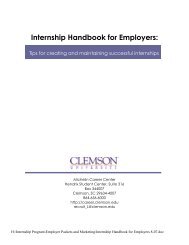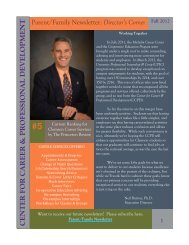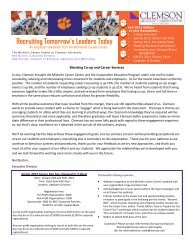Personal Statement - Michelin Career Center - Clemson University
Personal Statement - Michelin Career Center - Clemson University
Personal Statement - Michelin Career Center - Clemson University
You also want an ePaper? Increase the reach of your titles
YUMPU automatically turns print PDFs into web optimized ePapers that Google loves.
Writing a Draft<br />
After doing preliminary “research”, pick your story and write a personal statement draft.<br />
Don’t edit or worry about the length, just WRITE.<br />
Next, put your draft away for at least 2 weeks – don’t even look at it!<br />
At this point, it is more constructive to focus on what the essay shouldn’t be than what it should<br />
be. Here are some essay approaches that usually don’t work out:<br />
1. Funny<br />
Very few people can do funny so for the most part play it straight.<br />
2. Maudlin<br />
It is fine to acknowledge the role personal difficulties have played in your decisions about<br />
graduate school but keep the emotion to a minimum and focus on the facts and the future.<br />
3. Iconoclastic<br />
There is a persistent rumor that unusual, even outrageous, responses to a personal<br />
statement will get the admission’s committee’s attention and it will but it is almost<br />
always negative attention.<br />
4. Exhaustive Life History<br />
Don’t try to be comprehensive or strictly chronological and avoid beginning statements<br />
such as “As a child, I…” or “Such and such has always been my passion…”<br />
You don’t have to prove that you were born to your field of interest, in fact your story<br />
may be more intriguing if it shows how you were not born to a field but came to it<br />
through life experiences.<br />
5. The Resume<br />
Since you are free to attach a copy of your resume or CV to all graduate school<br />
applications, there is no need to waste your essay space by recounting your work history.<br />
If your statement is about how your work experiences have led you to apply, then keep<br />
the focus on the why and the how, not on the what of your work and your job history.<br />
Next Steps<br />
When you are satisfied that you are on the right track, do some editing. Also, get some feedback<br />
from a couple of people you know well. Some questions to consider are: is the essay coherent,<br />
does it reflect your story as they understand it, and most of all does the essay make them say,<br />
“yeah, that’s you.”<br />
At this point, you should look at the essay more closely. Now it is time to focus on what the<br />
essay is.<br />
1. Stress Unique Material<br />
Use the essay to talk about something that doesn’t come up anywhere else on your<br />
application, you want to give the admissions committee something new to think about.<br />
2. Concentrate On One Theme<br />
“What led me to apply to this program,” “The person who has most influenced my<br />
thinking,” and so on.<br />
3. Show, Don’t Tell<br />
Admissions committee has no reason to believe any general statement that you make<br />
about yourself unless you back it up with facts and evidence – that is what makes it<br />
persuasive.<br />
4. Tell Why, Not What<br />
Use your essay space to explain why an event was significant to you and what you<br />
learned from it – provide enough background so that your reader can follow what’s<br />
happening, but no more.<br />
Handout; <strong>Personal</strong> <strong>Statement</strong> for Graduate School SB 1/09








